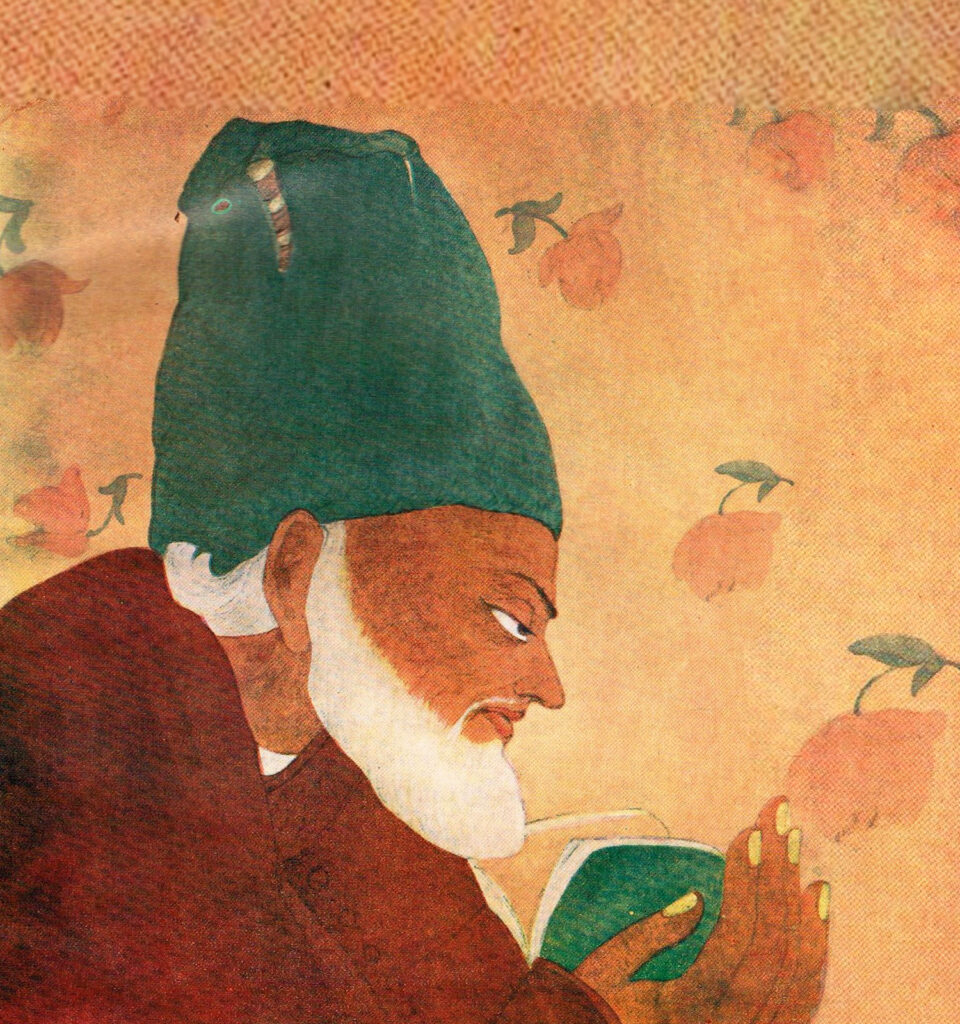A tribute to Urdu’s most popular poet, who remains an eternal contemporary, on his 154th death anniversary.
by Salim Arif
Poochhte Hain Wo Ke Ghalib Kaun Hai
Koi Batlao Ke Hum Batlayen Kya!
(Who is Ghalib, they ask
Can someone tell me what to say!)
~ Mirza Ghalib
Endowed with wit and candour, Ghalib—a nobleman poet of the Mughal Delhi in its twilight years—remains the most popular of the Urdu poets.
Brought up by his maternal grandfather’s family, Ghalib had a happy childhood, flying kites and loitering around in the lanes of Agra with his younger brother Yusuf and sister Chhoti Khaanam. He learned Persian from a well-known scholar, Abdus Samad, in addition to the basics of the Arabic language, elements of logic, philosophy, medicine etc. By the age of eleven, the young boy started writing poetry in Persian and some verses in Urdu as well.
Aate Hain Ghaib Se Ye Mazameen Khayaal Mein
Ghalib Sareer-e-Khaama Nawa-e-Sarosh hai
(What I write comes from the Unseen
Ghalib, the sound my pen makes while writing is an angel’s voice)
In 1810, when he was 13, Ghalib was married to an 11-year-old Umrao in an aristocratic family from Delhi where he settled for the rest of his life as a live-in son-in-law.
Delhi had a reinstated Mughal ruler restricted to a small region with the British forces hovering around. Delhi of that era offered temptations few young men could resist and the impressionable Asadullah got drawn to pastimes that were considered offensive to the conventional Muslim and social morality. Drinking of wine is forbidden in Islam as is the association with courtesans, but these two seem to have a place in Ghalib’s early life, which he often refers to in his poetry and letters.
Hoga Koi Aisa Bhi Ke Ghalib Ko Na Janane
Shayar To Woh Achha Hai Pa Badnam Bahut Hai
(Is there anyone who doesn’t know Ghalib
He is a good poet, though ill-famed)
But these meanderings never got better of him as his pursuit of Persian and poetic excellence remained a major occupation with Ghalib in Delhi.
A Sufi mystic by temperament, his frank admission of what was considered an evil, his sharp sense of humour and his cheerfully avowed unorthodoxy with regard to the more stringent formalities of his Muslim religion endeared him as a legend in his own lifetime.
Ye Masail-e-Tassawuf, Ye Tera Bayan Ghalib
Tujhe Hum Wali Samajhte Jo Na Bada Khwar Hota
(These matters of Sufi thought, and your manner of speech
We would have taken you for a saint, but for your drinking habits)
In the verses of Ghalib, the priest and the preacher are a target of satire.
Kahan Maikhane Ka Darwaza Ghalib Aur Kahan Waiz
Par Itna Jante Hain Kal Woh Jata Tha Ke Hum Nikle
(Mullah on the threshold of tavern, Ghalib!
But he did step in yesterday just as I left)
Ghalib never hesitated from taking a dig at religious beliefs.
Hum Ko Maloom Hai Jannat Ki Haqeeqat Lekin
Dil Ke Khush Rakhne Ko Ghalib Ye Khayaal Achha Hai
(I know the truth about paradise
But, not bad to have a belief if it pleases the heart)
When asked about his religion by an English Magistrate, Ghalib said: “Aadha Musalman – half Muslim.”
Intrigued, the magistrate asked for an explanation to which Ghalib said: “Huzoor, sharab peeta hoon, suar nahi khata – sir, I drink but don’t eat pork.”
When a friend told him that the prayers of a man who drinks aren’t answered, Ghalib quipped: “When you’ve drinks, why do you need to pray?”
Equipped with an ironic skepticism and wit that enhanced his capacity to absorb adversity, Ghalib insulated himself against bitter experiences that would have taken a heavy toll on any average mortal.
Although Persian was still the language of the court, Urdu had come of age and was accepted as the medium of poetry much before Ghalib came to Delhi. Bahadur Shah Zafar, who was also an Urdu poet of some merit, was destined to be the last emperor to sit on the Mughal throne. But, while his Mughal ancestors had controlled most of India, the aged Zafar wasn’t even a shadow of that.
Deprived of real political power by the East India Company, Zafar nevertheless presided over one of the great cultural renaissances of the Indian history and succeeded in creating an assembly of great poets patronised by the durbar. Ghalib too started writing in Rekhta (as Urdu was known then), shuffling between Asad and Ghalib as his pen names, and expected a place in the court of the king. The Delhi school of poets found him not to their liking and resisted his entry into what was considered an exclusive literary society. Similar to the famed rivalry of Mozart and Salieri, Ghalib seemed to have one with Ustad Zauq who was then the appointed mentor of Zafar to finesse his verses, a position that was to come to Ghalib later.
While Ghalib loved to see himself more as a Persian scholar and poet, it is his slim volume of Urdu poetry that gives him a lasting place in the world of literature as well as a huge following. Interspersed with shades of Persian and Arabic, Ghalib’s poetry has charming images of culture rooted in the Indian ethos.
Hindostan Saya-e-Gul Paay-e-Takht Tha
Jaho Jalal-e-Ahde Visal-e-Butaan na Poochh
(India’s capital was in the lap of spring
How do I describe the pomp and glory of the days!)
There is much in the poetry of Ghalib that gets across without any difficulty. To him, poetry wasn’t a mere arrangement of words, but something deeply significant to put across the experiences of the heart. And he expressed them in the most economical and quotable couplets that are, to this day, popular and relevant. Ghalib’s poetry and diction makes us feel as if it is our experience echoed in his words.
Dekhna Taqreer Ki Lazzat Ke Jo Us Ne Kaha
Main Ne Ye Jana Ki Goya Ye Bhi Mere Dil Mein Hai
(Just see the sweetness of his speech! Everything I hear him say, I feel it is in my heart too)
Mirza Ghalib was historically placed to witness a major transition of culture in India – the decline and dismantling of the Mughal culture and the rise of a British-led imposition of a new way of life that was to leave an indelible mark on the destiny of the subcontinent.
In May 1857, Bahdur Shah Zafar’s flourishing capital became the centre of an uprising that subsequently reduced his beloved Delhi to battered, desolate ruins.
Yaad Theen Humko Bhi Rangarang Bazm Arayiyan
Lekin Ab Naqsh-o-Nigare Taq-e-Nisyan Ho Gayin
(I too remember gatherings rich in all kinds of beauty
Now there are mere forms and patterns in the niche of memory)
Ghalib left his indelible mark not only on Urdu poetry, but also on prose with his volume of letters. Written in an informal style, devoid of any formality of letter writing prevalent then, Ghalib’s letters constitute a body of work in a relaxed, everyday prose which is a spontaneous documentation of his times and concerns. They also throw light on his state of being in a way that defines his poetic manifestations. The love that Ghalib has for his wife – unending and more passionate than his affair with his words – the love that he has for the city of Delhi which berates him, tests him and then accepts him in a way that it still hasn’t let him go. The unrequited love that a kothewali (courtesan) has for Ghalib and his poetry also finds a place in his letters written to his friends and disciples. His description of Delhi and its surrounding post-1857 destruction is a rare firsthand account. Although Ghalib was confined to his house during the Mutiny and its aftermath, he was deeply affected to reflect on those tumultuous happenings around him with a huge volume of letters in Urdu to his friends and a whole book Dastambo in Persian. His sensitive soul sublimates all his pathos through his powerful words and their placement.
Meri Qismat Mein Gham Gar Itna Tha
Dil Bhi Yarab Kai diye Hote
(If I had so much of sorrow in my life
Wish you had blessed me with numerous hearts, O Almighty!)
Ghalib lived his last days in sorrow, but yet the optimist in him always saw the brighter side.
Not only was he a poet of his times, but also of the future generations because of his ability to weave thoughts and feelings that are universal and at the fulcrum of human life. He remains an eternal contemporary, a poet for the centuries to come, as he himself proclaims:
Hoon Garmi-e-Nishat-e-Tassawur Se Naghma Sanj
Main Andleeb-e-Gulshan-e-Naafreeda Hoon
(I sing with joy when I imagine tomorrow
I am the lark of a garden that is yet to be)
Salim Arif is a National School of Drama (NSD) alumnus credited with bringing Urdu back into the mainstream Indian theatre.


